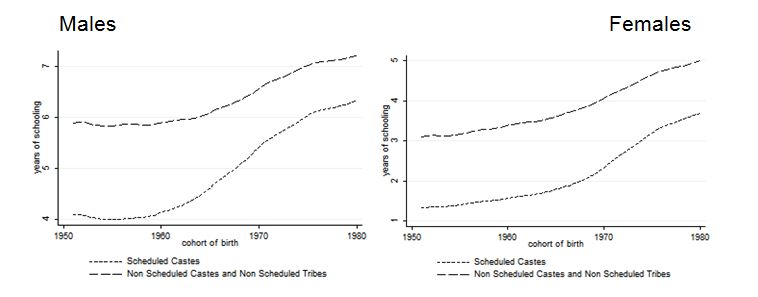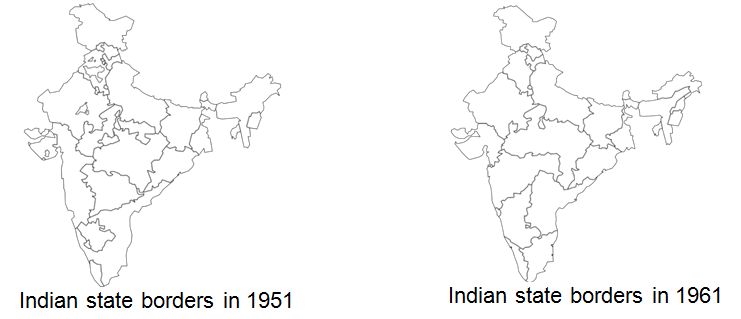Reservation for backward classes in schools has been in place in India since independence. This column uses a unique historical event that took place in the 1970s in India to evaluate the effect of access to reservation on school attainment of Scheduled Castes. It finds that these policies benefitted male SCs only.
The debate on affirmative action in education in India is particularly strong. However, very little is known about the impact of these policies on the educational outcomes of the intended beneficiaries (see I4I column by Gaurav Khanna for an evaluation of affirmative action policies on the educational attainment of Other Backward Classes (OBCs)).
In a recent study, I use a unique historical event that took place in the 1970s in India to evaluate the effect of access to affirmative action programmes on school attainment of Scheduled Castes (SC) (Cassan 2014).
Measuring the impact of affirmative action policies on educational outcomes of beneficiaries
Measuring the impact of affirmative action policies is not an easy task. The target population of such programmes is by definition very specific and therefore it is difficult to find a ‘counterfactual’ - a population similar to the targeted population in every aspect except in its access to the policy. Hence, while the gap in the number of years of schooling between SCs and the general population has decreased over the past decades for males (and not so much for females) (Figure 1), the exact role played by affirmative action policies in this evolution is hard to distinguish from other policies targeting the poor, or from a general convergence that could have taken place anyway.
Figure 1. Evolution of schooling years, by birth cohort

 Source: National Family Health Survey (NFHS) 1999.
Source: National Family Health Survey (NFHS) 1999.
This study takes advantage of an unusual historical event which allows for distinguishing the specific role of affirmative action policies on the educational attainment of SCs.
The castes targeted by affirmative action policies were defined after the writing of the Constitution in 1949 by each state, by geographical area within the state. Hence, some castes were considered as SC in one state, but not in another, and within a state, in a given area while not in another. Moreover, in 1956, the borders of Indian states changed drastically (Figure 2) but the geographical definition of the SC lists remained unchanged. This greatly multiplied the cases in which a caste could be considered as SC in one part of a state and not in another part of the same state: those cases were labelled “area restrictions”.
For administrative reasons, this situation lasted for 20 years until, in 1976, the SC lists were harmonised within each state and most of the within-state area restrictions were removed. Therefore, in 1976, some castes that should have had SC status in their area since 1956, finally obtained the benefits of affirmative action policies. In other words, individuals similar in all aspects to other SCs in their state (that had SC status since 1949) obtained the SC status in 1976 only. Hence, comparing individuals that were considered SC before 1976 to those that ‘became’ SC in 1976 allows for measuring the specific effect of affirmative action policies on beneficiaries.
Figure 2. Change in the borders of Indian states


Reservation in education has only benefited male SCs in India
Using NFHS data from 19991, I compare the cohorts (groups) that were above primary school age in 1977 (the year in which the policy became effective) to those of primary school age at that time to measure the impact of access to SC status, and hence affirmative action policies, on schooling decisions. Comparing individuals that became SC in 1976 to those from the same state that were already SC since 1949 allows the attribution of any difference in educational outcomes between the two groups to the affirmative action programme.
I find that access to SC status did lead to an increase in the educational attainment of the beneficiaries, but that this increase was unevenly distributed. Indeed, in line with the evolution shown in Figure 1, while males saw their years of schooling increase (by 0.8 years on average), females were unaffected. For girls, the access to reservation policies did not seem to translate into increased schooling completion.
This study contributes to a finer understanding of the impact of the Indian affirmative action programme. It provides the first quantitative evidence pointing to the varied effect, by gender, of reservation in education for SCs in the 1970s. Indeed, only males SCs benefited from the programme. In conclusion, while reservation policies have been able to obtain some success in reducing the schooling gap between the SCs and the general population, this catching up is seen for SC males only; the policy does not seem to have been able to reach girls from backward classes.
Notes:
- The 1999 round of the NFHS is the latest round available containing information of the caste name of the respondent as well as the district of residence, two prerequisite for the analysis.
Further reading
- Cassan, G (2014), ‘Affirmative Action, Education and Gender: Evidence from India’, CRED Working Paper.
- Khanna, G (2013), ‘That´s Affirmative: Incentivizing Standards or Standardizing Incentives?’, 5 December 2013. Available at SSRN: http://papers.ssrn.com/sol3/papers.cfm?abstract_id=2246549.
- Khanna, G (2014), ‘Quotas and schooling decisions’, Ideas for India, 3 April 2014.




 16 October, 2014
16 October, 2014 




Comments will be held for moderation. Your contact information will not be made public.